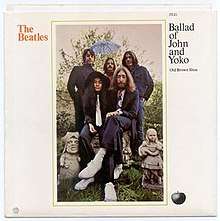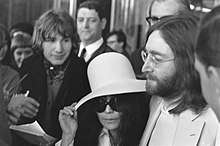The Ballad of John and Yoko
| "The Ballad of John and Yoko" | ||||
|---|---|---|---|---|
 US picture sleeve | ||||
| Single by the Beatles | ||||
| B-side | "Old Brown Shoe" | |||
| Released | 30 May 1969 | |||
| Format | 7-inch record | |||
| Recorded |
14 April 1969 EMI Studios, London | |||
| Genre | ||||
| Length | 2:59 | |||
| Label | Apple | |||
| Songwriter(s) | Lennon–McCartney | |||
| Producer(s) | George Martin | |||
| The Beatles singles chronology | ||||
| ||||
| Music video | ||||
| "The Ballad of John and Yoko" on YouTube | ||||
"The Ballad of John and Yoko" is a song written by John Lennon,[3][4] attributed to Lennon–McCartney as was the custom, and released by the Beatles as a single in May 1969. The song, chronicling the events associated with Lennon’s marriage to Yoko Ono, was the Beatles’ 17th and final UK No. 1 single.[5]
Writing
Authored by Lennon while on his honeymoon in Paris,[4] it tells of the events of his marriage, in March 1969, to Ono, and their publicly held honeymoon activities, including their "Bed-In" at the Amsterdam Hilton Hotel and their demonstration of "bagism".[6]
Lennon brought the song to McCartney’s home on 14 April 1969, before recording it that evening.[7][8][9] Recalling the controversy engendered by Lennon's "more popular than Jesus" remark in 1966, McCartney was alarmed at the references to 'Christ' in the new song but agreed to assist Lennon.[10] Ono later said: "Paul knew that people were being nasty to John, and he just wanted to make it well for him. Paul has a very brotherly side to him."[11]
Recording
The song was recorded without George Harrison (who was on holiday) and Ringo Starr (who was filming The Magic Christian).[12][13] In Barry Miles' biography, McCartney recalls that Lennon had a sudden inspiration for the song and had suggested that the two of them should record it immediately, without waiting for the other Beatles to return.[12] Reflecting this somewhat unusual situation, the session recordings include the following exchange:
- Lennon (on guitar): "Go a bit faster, Ringo!"
- McCartney (on drums): "OK, George!"[12]
The session marked the return of Geoff Emerick as recording engineer at a Beatles session after he had quit working with the group during the tense White Album sessions nine months earlier.[13] Commenting in the Beatles Anthology book, Harrison said: "I didn't mind not being on the record, because it was none of my business … If it had been 'The Ballad of John, George and Yoko', then I would have been on it."[14]
Release

Backed with Harrison’s "Old Brown Shoe", the single was released in the United Kingdom on 30 May 1969. Lennon and Ono were performing a second Bed-In at the Queen Elizabeth Hotel in Montreal at the time. The United States release followed on 4 June.[15]
In the UK and Europe, it was the first Beatles single to be released in stereo. It was therefore the first release not given a mono mix.[13]
The song has been included on several compilation albums: Hey Jude (US, 1970), 1967–1970 (1973), 20 Greatest Hits (UK, 1982), Past Masters (1988) and 1 (2000).
An uncredited 20-second sample of the song is used in the title track of Timothy Leary's 1970 album You Can Be Anyone This Time Around, with Leary's words: "You can be anyone this time around; John and Yoko this time around" spoken over the sample.
Reception
Several US radio stations declined to broadcast the song[16][17] because of what they saw as sacrilegious use of the words "Christ" and "crucify" in the chorus:
Christ you know it ain’t easy
You know how hard it can be
The way things are going
They’re gonna crucify me
"The Ballad of John and Yoko" never appeared on the surveys of WLS in Chicago or WABC in New York, two of the largest Top 40 stations in the US.
In 2012 the song was ranked as the 404th best classic rock song of all time by New York's Q104.3.[18]
The Spanish government under Franco objected to the song because of its statement, "Peter Brown called to say, 'You can make it OK, you can get married in Gibraltar near Spain.'" The status of Gibraltar is a long-running subject of debate between Spain and the United Kingdom.[3]
The single became the Beatles' 17th and final UK No. 1;[5] it reached No. 8 in the US.[19]
When cartoonist Al Capp visited John Lennon and Yoko Ono at their 1969 Bed-In for Peace in Montreal, Capp pointedly asked Lennon about the meaning of the lyrics of the song. Their testy exchange later appeared in the 1988 documentary film Imagine: John Lennon. On Capp's exit, Lennon sang an impromptu version with a slightly revised, but nonetheless prophetic lyric: "Christ you know it ain't easy / You know how hard it can be / The way things are goin' / They're gonna crucify Capp!"
Cover versions
- Israeli singer Arik Einstein and The Churchills recorded a Hebrew version of the song called "Haya lanu tov, nihiya lanu ra" (היה לנו טוב נהיה לנו רע). Released in 1969, the same year as the original, it features different lyrics rather than a translation.
- Finnish singer-songwriter Kari Peitsamo recorded a Finnish version of the song called Balladi Kari Peitsamosta in 1978.
- Brazilian rock band Titãs recorded a Portuguese language version of the song for their 1984 self-titled debut album.
- Dave Edmunds at John Lennon tribute concert in Liverpool 1990
- Beatallica recorded a mashup of the song and Metallica's "Battery" titled "The Battery of Jaymz and Yoko", on their 2009 album Masterful Mystery Tour.
- American jam band Widespread Panic has performed the song live on multiple occasions and an acoustic version is featured on their 2012 album Wood.
- Scottish band Teenage Fanclub released a cover of the song as a single (1990) and on their B-Sides and rarities compilation album Deep Fried Fanclub.
- Greek rock artist Pavlos Sidiropoulos recorded (1989) a live cover of this song with different lyrics in Greek. The song's name is "Tis Ethnikis Simfiliosis" (Της Εθνικής συμφιλίωσης) with mostly political humorous content
Personnel
According to Ian MacDonald[20] and Mark Lewisohn:[13]
- John Lennon – lead vocal, lead guitars, acoustic guitar, percussion
- Paul McCartney – harmony vocal, bass guitar, drums, piano, maracas
Charts and certifications
Charts
|
Certifications
| |||||||||||||||||||||||||||||||||||
Notes
- ↑ "The Beatles 'The Ballad of John and Yoko'". AllMusic. Retrieved 23 November 2014.
- ↑ Doyle Greene (17 February 2016). Rock, Counterculture and the Avant-Garde, 1966-1970: How the Beatles, Frank Zappa and the Velvet Underground Defined an Era. McFarland. p. 68. ISBN 978-1-4766-6214-5.
- 1 2 Fontenot.
- 1 2 Smith 1980, JOHN: "I wrote that in Paris on our honeymoon. It's a piece of journalism. It's a folk song.".
- 1 2 Official UK Charts 2009.
- ↑ Guesdon & Margotin 2013, p. 542.
- ↑ Smith 1988, PAUL: "John came to me and said, 'I've got this song about our wedding and it's called The Ballad Of John And Yoko.' He came around to my house, wanting to do it really quick. He needed to record it so we just ran in and did it.".
- ↑ Harry 2003, 'B': "On Monday 14 April 1969 John brought the number around to Paul's house in Cavendish Avenue for him to aid in its completion.".
- ↑ Miles 1997, p. 551: "John brought it round to Paul's house on 14 April 1969 for him to help complete".
- ↑ Guesdon & Margotin 2013, p. 544.
- ↑ "48 - 'The Ballad of John and Yoko'". 100 Greatest Beatles Songs. Rolling Stone. Retrieved 20 June 2012.
- 1 2 3 Miles 1997, p. 551.
- 1 2 3 4 Lewisohn 1988, p. 173.
- ↑ The Beatles (2000). The Beatles Anthology. San Francisco, CA: Chronicle Books. p. 333. ISBN 0-8118-2684-8.
- ↑ Lewisohn 1988, p. 200.
- ↑ Fong-Torres 1969.
- ↑ Cross 2005, pp. 539–540.
- ↑ "The Top 1,043 Classic Rock Songs of All Time: Dirty Dozenth Edition". Q1043.com. Archived from the original on 14 December 2013.
- ↑ Wallgren 1982, p. 55.
- ↑ MacDonald 2005, p. 345.
- ↑ Kent, David (2005). Australian Chart Book (1940–1969). Turramurra: Australian Chart Book. ISBN 0-646-44439-5.
- ↑ "Austriancharts.at – The Beatles – The Ballad of John and Yoko" (in German). Ö3 Austria Top 40. Retrieved 16 May 2016.
- ↑ "Ultratop.be – The Beatles – The Ballad of John and Yoko" (in Dutch). Ultratop 50. Retrieved 16 May 2016.
- ↑ "The Irish Charts – Search Results – The Ballad of John and Yoko". Irish Singles Chart. Retrieved 16 May 2016.
- ↑ "Dutchcharts.nl – The Beatles – The Ballad of John and Yoko" (in Dutch). Single Top 100. Retrieved 16 May 2016.
- ↑ "Norwegiancharts.com – The Beatles – The Ballad of John and Yoko". VG-lista. Retrieved 16 May 2016.
- ↑ "Swedish Charts 1966–1969/Kvällstoppen – Listresultaten vecka för vecka > Juni 1969" (PDF) (in Swedish). hitsallertijden.nl. Retrieved 21 February 2018.
- ↑ "Swisscharts.com – The Beatles – The Ballad of John and Yoko". Swiss Singles Chart. Retrieved 16 May 2016.
- ↑ "Official Singles Chart Top 100". Official Charts Company. Retrieved 16 May 2016.
- ↑ "The Beatles Chart History (Hot 100)". Billboard. Retrieved 16 May 2016.
- ↑ Hoffmann, Frank (1983). The Cash Box Singles Charts, 1950-1981. Metuchen, NJ & London: The Scarecrow Press, Inc. pp. 32–34.
- ↑ "Offizielle Deutsche Charts" (Enter "Beatles" in the search box) (in German). GfK Entertainment Charts. Retrieved 16 May 2016.
- ↑ "American single certifications – The Beatles – The Ballad of John and Yoko". Recording Industry Association of America. Retrieved 14 May 2016. If necessary, click Advanced, then click Format, then select Single, then click SEARCH.
References
- "Beatles - The Ballad of John and Yoko". Official UK Charts Company. 2009. Archived from the original on 12 November 2006. Retrieved 28 November 2009.
- Cross, Craig (2005). The Beatles: Day-by-Day, Song-by-Song, Record-by-Record. Lincoln: iUniverse, Inc. ISBN 0-595-34663-4.
- Fong-Torres, Ben (26 July 1969). "Christ, They Know It Ain't Easy". Rolling Stone.
When 'Ballad' was released in late May, dozens of stations immediately announced a ban. Program directors have called the casual reference to the deity 'profane,' 'sacrilegious,' 'offensive,' and 'generally objectionable.'
- Fontenot, Robert (2010). "The Ballad of John and Yoko". About.com.
- Guesdon, Jean-Michel; Margotin, Philippe (2013). All the Songs: The Story Behind Every Beatles Release. New York, NY: Black Dog & Leventhal. ISBN 978-1-57912-952-1.
- Harry, Bill (2003). The Paul McCartney Encyclopedia. Virgin Books. ISBN 978-0-7535-0716-2.
- Lewisohn, Mark (1988). The Beatles Recording Sessions. New York: Harmony Books. ISBN 0-517-57066-1.
- MacDonald, Ian (2005). Revolution in the Head: The Beatles' Records and the Sixties (Second Revised ed.). London: Pimlico (Rand). ISBN 1-84413-828-3.
- Miles, Barry (1997). Paul McCartney: Many Years From Now. Henry Holt & Company. ISBN 0-8050-5248-8.
- Smith, Alan (3 May 1969). "Beatles Music Straightforward on Next Album". New Music Express.
- Smith, Alan. "Beatles Ultimate Experience: Songwriting & Recording Database". New Music Express.
- Wallgren, Mark (1982). The Beatles on Record. New York: Simon & Schuster. ISBN 0-671-45682-2.